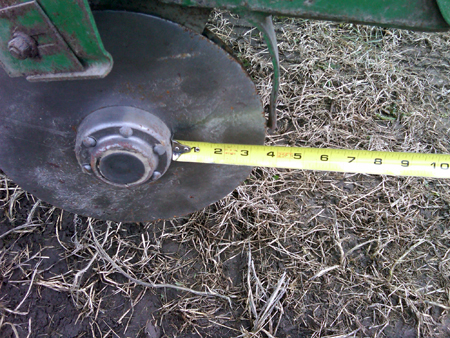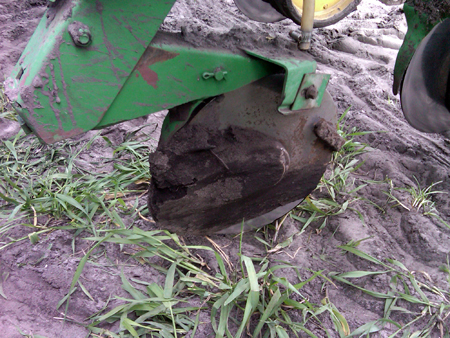Don’t forget to check your fertilizer openers
Proper maintenance helps prevent injury to seedlings and ensures an even stand.
Don’t forget to check the often neglected starter fertilizer equipment on your planter. MSU as well as several other universities recommend placing the starter band 2 inches to the side and 2 inches below the seed for many crops including corn and dry beans. Proper placement ensures that the fertilizer nutrients are in a place where they can be readily utilized by the young seedling, yet far enough away not to cause injury to the tender germinating seed.
Worn out fertilizer opener disks are a common problem observed on many planters. As the opener disks wear down, the starter band becomes more and more shallow, potentially leading to problems associated with starter injury or ineffectiveness. Photo 1 shows an opener disk on a planter that is well past it serviceable life, with just over 3 inches of blade past the hub, this opener has little chance of placing the band 3 1/2 to 4 inches below the soil surface.

Photo 1. Opener disk on a planter well past its serviceable life.
Partially frozen, nearly worn out, or worn out opener bearings are another issue. When the openers stop turning and begin to plow (Photo 2), it affects placement of the starter band and the seed furrow.

Photo 2. Effects of an opener disk not turning and beginning to plow.
Worn pivot points in the opener arm can also be the cause of a misplaced starter band. If the opener begins to favor one side, either too close or too far away from the seed, or to wander from side to side, the starter band will not be in its intended position.
Drive mechanisms also merit some attention. Like the seed units, a smooth, even drive is preferred over the stop and go of binding shafts and frozen chain links.
Check dry fertilizer hoppers for unevenly worn or missing auger flighting. This can cause one hopper, or section of a hopper, to apply a lower rate than the hopper next to it. When refilling the hoppers during planting, always be on the lookout for a hopper that is not emptying at the same rate as the others.
On the liquid systems, check the pump regularly. On squeeze pumps, check the hoses for leaks and for uneven wear and the rollers for smooth operation. On all liquid systems, check lines leading from the pump to the openers periodically for leaks, kinks and plugging.
At least once per season, and periodically, perform a calibration check to be sure the planter is applying fertilizer evenly across all rows.
And lastly, as we are waiting for the soil to warm, give the operators manual one more look and always remember to observe all safety precautions.
For more information, also read my article Check your planter before you go to the field.



 Print
Print Email
Email




